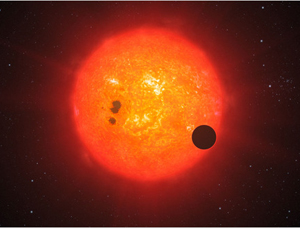New DARK post doc on team that discovers Earth-sized exoplanet
A solid planet approximately 1½ times the size of the Earth has been observed outside our solar system. It is the smallest planet found so far in the hunt for planets in our galaxy, the Milky Way. The planet was observed by NASA’s Kepler Mission, and Danish researchers from the Niels Bohr Institute at the University of Copenhagen and Aarhus University took part in the research. The results are published in The Astrophysical Journal.

Credit: ESO
The newly discovered planet has been named Kepler-10b. Planets outside our solar system are called exoplanets and the exoplanet Kepler-10b orbits a star that is approximately 564 light years away. The Milky Way is a large spiral galaxy that is 100,000 light years in diameter and 1,000 light years thick, so the planet is in our galactic neighbourhood.
"It is a super-Earth planet as we call the category of planets that are 1-10 times the mass of the Earth", explains Lars Buchhave. The newfound planet is 1.4 times the size of the Earth and it is 4.6 times more massive than the Earth, so the conclusion is that its average density is the same as iron. Its orbital period is 0.84 days, so its “year” is less than one day. It may very well have a rocky surface like the Earth, but it lies very close to the star so it is very hot on the surface – around 1560 degrees C, so there is no possibility for life as we know it on Earth.
"Out of the 100 dimming exoplanets that have been found up until now, there are only 2 other small Earth-sized planets, so it is an important discovery, as we are now coming closer and closer to finding a planet that resembles our own planet Earth", explains Lars Buchhave, who is expecting a great deal from the coming years’ hunt for exoplanets that are habitable for life.
